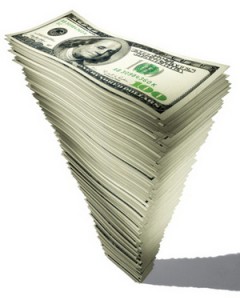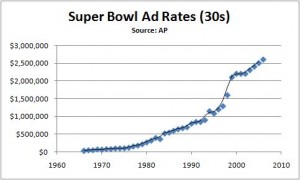Kristin Pohaski is an IMC student from the IMC 404 class.
 Two and a half million dollars can buy a lavish home, luxury cars, trips to exotic locales – or 30 seconds of air time during Super Bowl XLV. In 1966, the same spot during Super Bowl I cost $42,500, or about $278,000 in today’s dollars. The price crossed the $1 million mark in 1994, $2 million in 1999 and $3 million in 2008. With the price of advertising skyrocketing, will advertisers say enough is enough? Some already have.
Two and a half million dollars can buy a lavish home, luxury cars, trips to exotic locales – or 30 seconds of air time during Super Bowl XLV. In 1966, the same spot during Super Bowl I cost $42,500, or about $278,000 in today’s dollars. The price crossed the $1 million mark in 1994, $2 million in 1999 and $3 million in 2008. With the price of advertising skyrocketing, will advertisers say enough is enough? Some already have.
Last year, several traditional Super Bowl ad companies sat on the bench. GM and FedEx both passed on ads last year. Pepsi didn’t run a spot for the first time in 23 years. This year, big names like Denny’s, Dr. Pepper and Monster did not appear. Instead of running a commercial, Papa John’s gave away free pizzas to random customers during the game and promised to give one free to anyone who signed up in advance if the game ran into overtime (it didn’t). “We’d rather give away millions in free pizzas than spend millions on a spot,” says Andrew Varga, Papa John’s marketing chief. Prices for a spot were cut from $3 million to $2.5 million this year, the second year in a row and only the third time ever that prices have dropped.
The effect isn’t limited to huge expenditures like a Super Bowl spot. Ross Petrocelli, Interactive Account Executive for Marc USA, says he has seen “ a lot of shopping around” from clients. “Media spending has morphed dramatically, with more and more going from print to online. I’m seeing much more interactive work, especially in social, location based services and mobile overall.” Smart phones and an increasingly technologically advanced Web offer many new advertising vehicles that are competitively priced.
 Along with a shift in media spending is a shift in agency compensation. For years, agencies were compensated a percent of their billings. Today, the corporate world is demanding accountability from their agencies. Many have shifted to a performance-based system of compensation, holding agencies accountable for results, or a lack thereof. Companies are also moving towards a complete Integrated Marketing Communications program, and in the process they are shifting more of their focus to other areas such as public relations, which can cost pennies on the dollar compared to traditional advertising.
Along with a shift in media spending is a shift in agency compensation. For years, agencies were compensated a percent of their billings. Today, the corporate world is demanding accountability from their agencies. Many have shifted to a performance-based system of compensation, holding agencies accountable for results, or a lack thereof. Companies are also moving towards a complete Integrated Marketing Communications program, and in the process they are shifting more of their focus to other areas such as public relations, which can cost pennies on the dollar compared to traditional advertising.
Could advertising be the next bubble to burst, or will prices continue to rise? One thing is certain – traditional advertising will need to prove its worth to continue at today’s high price points.
I used to think the same thing. Companies spend tons of money on an ad/commercial and it only lasts a minute or less. The Super Bowl ads have “exploded” over the years in popularity also. Some football fans anticipate the commercials more than the actual game. I do have to admit that the advertising in some of the ads are clever. They wait until one time of year to pull out all the stops and sell their product and these fans will go out and buy that item immediately!